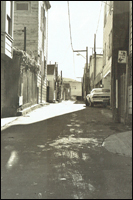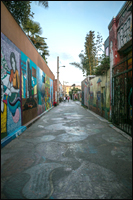Bambang Toko, Bangkit/Arise, Codit, Harind Arvati, Megan Wilson, Nano Warsono, Nurohmad, Ucup, Vina Puspita, Wedhar Riyadi, Yogyakarta Indonesia, 2018

Bangkit/Arise is an international arts exchange and residency between artists from the San Francisco/Bay Area, USA and Yogyakarta Indonesia. The lead sponsoring organization for Bangkit/Arise is Clarion Alley Mural Project, based in San Francisco in collaboration with the Asian Art Museum Chong Moon Lee Center for Asian Art and Culture. The projects partners in Yogyakarta Indonesia are Desa Panggungharjo and the Institut Seni Indonesia, Yogyakarta.
In July/August 2018 five of the artists from the SF/Bay Area – Kelly Ording, Jet Martinez, Jose Guerra, Christopher Statton and Megan Wilson arrived in Yogyakarta to spend 5 – 7 weeks as part of the residency exchange. Unfortunately because of greater geopolitical circumstances, two of the Bay Area artists – Shaghayegh Cyrous and Keyvan Shovir were unable travel and to be a part of the first phase of the exchange; however, they are still very much a part of the exchange and will be traveling to Yogyakarta as soon as it is possible.

As part of Bangkit/Arise’s collaboration with Desa Panggungharjo the Yogyakarta Bangkit/Arise artists Nano Warsono, Hari Ndvarwati, Ucup, Bambang Toko, Codit, Wedhar Riyadi, and Vina Puspita created a mural at Panggungharjo’s sports center to honor important figures who have had a significant impact on Indonesia’s history. Batik artist Nurohmad created the batik background throughout the mural and San Francisco artist Megan Wilson painted several of her signature flowers on the dedication wall. Sama-sama!
The mural included an evening of ritual to bless the honoring of the local and national s/heroes in Indonesia:

The figures on top include:
Dr. Sardjito: Prof. Dr. M. Sardjito (born in Magetan , East Java , August 13, 1889 – died May 5, 1970 at the age of 80) was a doctor who was Professor of the Faculty of Medicine , Gadjah Mada University . He graduated from Purwodadi Elementary School in Purwodadi Village , West District , Magetan Regency in 1922. During the war of independence, he participated in the process of transferring the Pasteur Institute in Bandung to Klaten. Next he became President of the Universiteit (now called Chancellor) of the first Gadjah Mada University from the beginning of UGM’s establishment in 1949 to 1961.The name is enshrined as the name of the regional hospital in Yogjakarta, the Central General Hospital Dr. Sardjito.
Gusdur: Abdurrahman Wahid born Abdurrahman ad-Dakhil September 1940 – 30 December 2009), colloquially known as Gus Dur, was an Indonesian Muslim religious and political leader who served as the President of Indonesia from 1999 to 2001. The long-time president of the Nahdlatul Ulama and the founder of the National Awakening Party (PKB), Wahid was the first elected president of Indonesia after the resignation of Suharto in 1998.
R.A. Kartini: Raden Adjeng Kartini (21 April 1879 – 17 September 1904), sometimes known as Raden Ayu Kartini, was a prominent Indonesian national heroine from Java. She was also a pioneer in the area of education for girls and women’s rights for Indonesians. Her birthday is now celebrated as Kartini Day in Indonesia. She took an interest in mysticism and opposed polygamy. Her advocacy for the education of girls was continued by her sisters. Kartini Schools were named for her and a fund established in her name to fund the education of girls.
Yap Thiam Hiem: Born in Kutaraja, Aceh, Dutch East Indies, his father was Yap Sin Eng and his mother was Hwan Tjing Nio. Yap was of Chinese heritage and was an advocate for human rights. He believed achieving minority rights needed to be part of the larger struggle for the rights of all people.Together with Adnan Buyung Nasution, Mochtar Lubis, P.K. Ojong, Victor D. Sibarani, Albert Hasibuan, Bambang Widjojanto, Johannes Cornelis Princen and other notable human rights activists and lawyers, Yap was one of the founders of Yayasan Lembaga Bantuan Hukum Indonesia (YLBHI), formerly known as Lembaga Bantuan Hukum (LBH), which was a legal aid society to help the poor.
Jendral Sudirman: General of the Army Raden Soedirman (Perfected Spelling: Sudirman; 24 January 1916 – 29 January 1950) was a high-ranking Indonesian military officer during the Indonesian National Revolution. The first commander of the Indonesian National Armed Forces, he continues to be widely respected in the country. He is buried at Semaki Heroes’ Cemetery in Yogyakarta.

Sukarno: Sukarno (born Kusno Sosrodihardjo; 6 June 1901 – 21 June 1970) was the first President of Indonesia, serving from 1945 to 1967. Sukarno was the leader of his country’s struggle for Independence from the Netherlands. He was a prominent leader of Indonesia’s nationalist movement during the Dutch colonial period, and spent over a decade under Dutch detention until released by the invading Japanese forces. Sukarno and his fellow nationalists collaborated to garner support for the Japanese war effort from the population, in exchange for Japanese aid in spreading nationalist ideas. Upon Japanese surrender, Sukarno and Mohammad Hatta declared Indonesian independence on 17 August 1945, and Sukarno was appointed as first president. He led Indonesians in resisting Dutch re-colonization efforts via diplomatic and military means until the Dutch acknowledgement of Indonesian independence in 1949. Author Pramoedya Ananta Toer once wrote “Sukarno was the only Asian leader of the modern era able to unify people of such differing ethnic, cultural and religious backgrounds without shedding a drop of blood.”
Muhammad Hatta: Mohammad Hatta (12 August 1902 – 14 March 1980) was Indonesia’s first vice president, later also serving as the country’s prime minister. Known as “The Proclamator”, he and a number of Indonesians, including the first president of Indonesia, Sukarno, fought for the independence of Indonesia from the Dutch. Hatta was born in Fort De Kock, West Sumatra, Dutch East Indies (now Indonesia). After his early education, he studied in Dutch schools in the Dutch East Indies and studied in the Netherlands from 1921 until 1932. Mohammad Hatta is often remembered as Bung Hatta (according to author Pramoedya Ananta Toer, “bung” is an affectionate title meaning “friend,” used to be a way of addressing a person in a familiar way, as an alternative to the old-form “tuan”, “mas” or “bang”).
K.H. Ahmad Dahlan: Kyai Haji Ahmad Dahlan (Arabic: أحمد دحلان; 1 August 1868 – 23 February 1923), born Muhammad Darwis, was an Indonesian Islamic revivalist who established Muhammadiyah in 1912. He was the 12th generation descendant of Maulana Malik Ibrahim with lineage traces back to Muhammad. As one of the growing group who regarded themselves as modernists, he was concerned at the many Javanese practices not justified by Islamic scripture and argued for the creation of a renewed purer Islam more in step with the modern world. He created Muhammadiyah in 1912 as an educational organization as a means of realizing his reformist ideals. It was quickly joined by traders and craftsmen. In 1917 added a women’s section named Aisyiyah, which played a significant role in modernizing the life of Indonesian women.
K.H. Hasyim Asyari: Hadratusy Syaikh KH.Hasyim Asy’ari (April 10, 1875 – July 25, 1947) was an Indonesian ulama and founder of Nahdatul Ulama. Hasyim Asy’ari’s ancestry can be traced to Sultan Hadiwijaya of Pajang, and further, to Brawijaya VI (Girindrawardhana), the last king of Majapahit. At the age of twenty, he married Khadijah, daughter of Pesantren Siwalan Panji leader. One year later, they went to Mecca. After seven months, his wife was dead and also his son, Abdullah two months later. In 1899, he founded Pesantren Tebuireng, which later became the largest pesantren in Java in the early 20th century. The pesantren also became the center for the reform of traditional Islamic teaching. On January 31, 1926 he and several traditional Islamic leaders founded Nahdatul Ulama (Awakening of Ulamas).
R.M.P. Sosrokartono: R.M.P. Sosrokartono or Raden Mas Panji Sosrokartono (born in Pelemkerep, Mayong, Jepara, April 10, 1877 – died in Bandung, Indonesia, February 8, 1952 at the age of 74). As a son of R.M. Ario Sosrodiningrat, R.M.P Sosrokartono is an older brother of R.A. Kartini, who inspired R.A. Kartini to become a female emancipation figure. Since he was young, he showed his intelligence, after graduating from the Europesche Lagere School in Jepara, Sosrokartono continued his education to H.B.S. in Semarang. Then in 1898, Sosrokartono continued his studies in the Netherlands by entering the Leiden High School of Engineering. However, because he felt unsuitable, he moved to the Department of Eastern Language and Literature so he graduated with a Doctorandus in de Oostersche Talen degree from Leiden College. He was the first Indonesian student to continue his education in the Netherlands, followed by other Indonesian sons.
Dewi Sartika: Dewi Sartika (4 December 1884 – 11 September 1947) was a campaigner for and pioneer of education for women in Indonesia. She founded the first school for women in the Dutch East Indies. She was honoured as a National Hero of Indonesia in 1966. On 16 January 1904, she founded a school named Sekolah Isteri at Bandung Regency’s Pendopo which later was relocated to Jalan Ciguriang and the school name changed to Sekolah Kaoetamaan Isteri (Wife Eminency School) in 1910. In 1912, there were nine Sekolah Kaoetamaan Isteri in cities or regencies in West Java (half of the cities and regencies), and in 1920 all of cities and regencies had one school. In September 1929, this school changed its name to Sekolah Raden Dewi.
Agus Salim: Haji Agus Salim([ˈaɡʊs ˈsalɪm]; born Mashudul Haq; October 8, 1884 – November 4, 1954) was one of Indonesia’s founding fathers and prominent diplomats. He played a leading role in the creation of the Indonesian constitution in 1945 and served as Indonesia’s Foreign Minister between 1947 and 1949. In the months preceding the proclamation of Indonesian independence, Salim was a member of the Investigating Committee for Preparatory Work for Indonesia Independence (BPUPKI) and the Committee of Nine that wrote the Jakarta Charter, which became the preamble to Indonesia’s constitution, including the Pancasila philosopy. Salim has been described as the “Grand Old Man of the Indonesian Independence movement and veteran leader of Indonesian Islam”. Sukarno described him as a “intellectual ulama” (Indonesian: ulama intelek), a leader combining Islamic science and Western teachings. Mohammad Hatta, called the Arabic de jurerecognition of Indonesian independence Salim’s greatest contribution to Indonesia[
The figures on the bottom are previous mayors of Panggungharjo – Sutrisno, Pawiro Sudarmo, Broto Asmoro, Siti Srimah Sri Zazuli, and H. Jaelani.C
On September 3rd six of the Yogyakarta artists – Nano Warsono, Bambang Toko, Ucup, Wedhar Riyadi, Vina Puspita and Harind Ndarvati arrived in San Francisco to spend 8 weeks in the Bay Area getting to work with our communities here. Sadly, one of the Indonesian artists – Codit – was unable to be a part of the current residency in San Francisco due to greater geopolitics; however, he too is still part of the exchange and will travel to San Francisco when possible.
Bangkit/Arise is designed to foster discussions, understanding, and action on critical social/political issues facing our global and local communities today using art as a point of departure. Subjects being addressed include:
- Community development and the role of art in supporting Civic Design through:
- Creating a culture of creativity;
- Placemaking;
- Community building and networking;
- The engagement of residents and visitors/tourists; and
- Economic growth and livelihood – the creative economy;
- The role of the public commons;
- Environmentalism and the critical need for a call to action;
- Current geopolitical divisions, xenophobia and how we envision a world rooted in social justice, equity, and collaboration;
- The need for radical inclusion and understanding differences and similarities as a means of strength and the goal of collectively dismantling local and global inequities/oppression.




































































